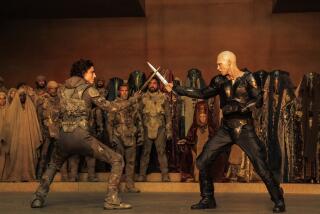Astral Weeks: A bread-and-circus future
My heart sinks when I open a new SF or fantasy novel for potential review, only to see the word “ Prologue.” Though not necessarily long, these scene-setters can be inscrutable, particularly when you realize you’re holding Volume 3 in the second of four linked star-faring trilogies.
“Ten thousand years have passed since the S’rwrwa annexed the outer colonies of the Confederation,” one of these might begin, “enslaving its peoples by means of superior firepower and the Naxx, an antiquated form of mass hypnosis perfected by the rogue wizards known as the Qmzic. Only the mysterious Weemim, a clan of psychic Hffr’z descended from the Grand Vizier Fungwafer VIII and his half-wolf concubine, continues to offer resistance. But overwhelmed by the S’rwrwa’s robot army, and the rise of the vicious Green Lord Exanthatrill, the Weemim are dying out. Their only hope is to bribe the Qmzic with the hallucinogenic seaweed they manage to harvest and use their powers to unlock the secrets of a small cube of intolerable dimensions called the Truculata . . . “
There’s nothing more off-putting than an undigested blob of information. Thankfully, the prologue to Lise Haines’ YA novel “Girl in the Arena” (Bloomsbury: 324 pp., $16.99) is an exception to the dreariness. Subtitled “The History of the Gladiator Sports Association” (or GSA), its voice differs from the standard third-person prologuese. (We discover that it’s actually part of a book being written by “Girl in the Arena’s” teen narrator, Lyn.) Just over six pages, the prologue does the required data dumping, explaining how mortal combat came to be a big (and legal) spectator sport in the novel’s version of contemporary America. But it’s brisk-moving history, with a wry satirical voice. Here, for instance, is the explanation of the fate of a Vietnam War draft dodger, whose death was the impetus for the league’s origins:
“Ned was a serious asthmatic whose condition became aggravated by any small contact with cats. So he borrowed nine of his friends’ tabbies and minxes and Persians and drove around in his VW Bug with the windows rolled up. The cats laced in and out of Ned’s lap, moved along the back of his seat. . . . The plan was to drive around the city and pull right up to an emergency room, and then 4F all the way. He just couldn’t find a hospital in time. The coroner said that Ned miscalculated the number of cats he needed in the car.”
It’s an inviting start, and we’re willing to enter Haines’ altered present tense, in which the nationwide but somewhat underground phenomenon of gladiatorial combat has gone mainstream, thanks in part to “Chuck Palahniuk, 9/11, the war in Iraq, and a self-help book selling in the millions called ‘The Mystery.’ ” (Think “The Secret.”) According to Lyn, after a company called Caesar’s Inc. took over gladiator gaming, death-row inmates and the terminally ill petitioned to be allowed into the arena, seeking a quicker death than life would allow. The possibility of mortal combat became part of the sport’s appeal.
At prologue’s end, Lyn identifies herself as “Daughter of Seven Gladiators,” a tag she is ambivalent about through much of the book. Her mother, Allison, is a loyal, sound-byte-savvy, flaky (during a trip to Rome, she muses on which empress she might have been in a past life, deciding, “It’s possible I was more than one”), and ultimately unhinged woman who has married and lost seven warriors in a row. She wants Lyn to follow her traditional, subservient route, first by enrolling in Gladiator Wives College.
Lyn rebels at the idea -- how could this be YA otherwise? -- but it turns out that she might become a “Glad wife” sooner than she thinks. Early in “Girl in the Arena,” Lyn’s most recent (and beloved) stepfather, Tommy, loses a match -- and his life -- to a younger fighter named Uber. As the crowd roars, Uber finds something on the arena floor: a silver bracelet that Lyn had given to Tommy for good luck. Unfortunately for her, it qualifies as a dowry bracelet, and (according to GSA bylaws) she is betrothed to Uber.
This is, to be honest, a major plot point that feels more arbitrary than realistic; why would such a rule exist? (Bylaw 87, “If a man holds your dowry bracelet he’s required, according to GSA law, to marry you.”) Still, the resulting situation kicks up the drama. A New York Times headline asks “WHEN MUST A DAUGHTER MARRY HER FATHER’S MURDERER?” The twisted yet universal emotional crux of the book is that Lyn is more than a little attracted to the man who should be her mortal enemy.
And is -- or so it seems. Haines keeps the romantic interest at a simmer, while Lyn declares her intention to fight Uber in the arena. The showdown is cleverly designed, and the novel’s girl-power heart is in the right place, but what makes “Girl in the Arena” tick is Lyn’s engaging, often-sardonic voice. “Normally I’d be at my fast-food job on Friday nights serving trans fat to the masses,” she deadpans near the beginning. She observes of Mark, her techie friend (and another possible romantic interest): “He’s wearing one of his shrunken T-shirts that conveys his work on both the major and minor muscle groups.” Then there’s the paradox that “cleaning up soap is not an easy task because it keeps trying to clean the thing you’re trying to clean.” She makes it easy to root for her.
Park is an editor of the Believer and the author of the novel “Personal Days.” Astral Weeks appears monthly at www.latimes.com/books.
More to Read
The biggest entertainment stories
Get our big stories about Hollywood, film, television, music, arts, culture and more right in your inbox as soon as they publish.
You may occasionally receive promotional content from the Los Angeles Times.






